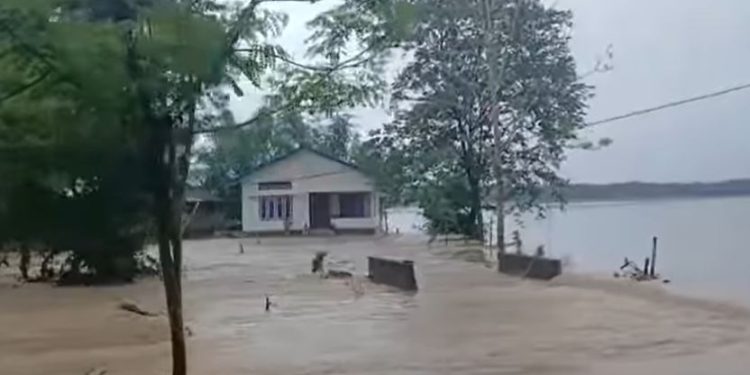Continuous heavy rainfall over the past three to four days has plunged several regions of Assam into a severe flood crisis, with Lakhimpur district bearing the brunt of the disaster. The situation escalated dramatically after the abrupt release of excess water from the Ranganadi Hydroelectric Project, operated by the North Eastern Electric Power Corporation (NEEPCO), submerging vast areas and displacing thousands of residents.
On Friday, NEEPCO opened gates 1 and 2 of the project, followed by four additional gates later that night, unleashing a massive volume of water. This sudden surge transformed floodplains in Lakhimpur, particularly in Pachnoi and surrounding low-lying areas, into a sea-like expanse. The deluge has claimed at least two lives—Biren Paw from Pachnoi and Raj Kumar Taid from Dambukial—leaving communities in mourning.
In Pachnoi, over a thousand families have been rendered homeless as floodwaters inundated homes, roads, and farmland. A critical road in the area suffered severe erosion, with nearly 100 meters washed away by the powerful current, isolating villages and destroying livestock and household belongings. In Amatola, a 200-meter section of a ring embankment collapsed under the force of the Ranganadi River, flooding at least five villages, including Majar Chapori, Nepali Gaon, and Amatola itself. Residents reported the river turning into a raging torrent early in the morning, engulfing entire communities.
The devastation extends to Pahumara, where roads in Atichuk and nearby villages have been destroyed, severing vital connections between Assam and Arunachal Pradesh. National Highway 15, near Mazgaon and Gendhali, is now underwater, further isolating the region. Over 40 villages, including Khaliha Mari and Mazgaon, are grappling with inundation, leaving residents stranded without food or clean drinking water.
Desperate villagers have resorted to building makeshift rafts from banana trunks to rescue those trapped by the rising waters. While the State Disaster Response Force (SDRF) and district authorities have deployed boats for rescue operations, locals criticize the response as inadequate given the scale of the crisis. “The government and NEEPCO left us to drown,” said a resident of Amatola, echoing widespread frustration.
Anger is mounting against NEEPCO, with locals accusing the agency of ignoring repeated calls to release dam water in smaller, regulated amounts. They label the sudden, massive discharge a “man-made calamity” that could have been prevented with better oversight. Criticism has also been directed at the government for failing to monitor NEEPCO’s operations or implement timely preventive measures.
As the floodwaters continue to spread, affecting areas like Pani Gaon and lower Amatola, the people of Lakhimpur face an uncertain future. With homes destroyed, infrastructure in ruins, and despair growing, there is an urgent need for immediate and robust intervention to deliver relief and mitigate further damage.





